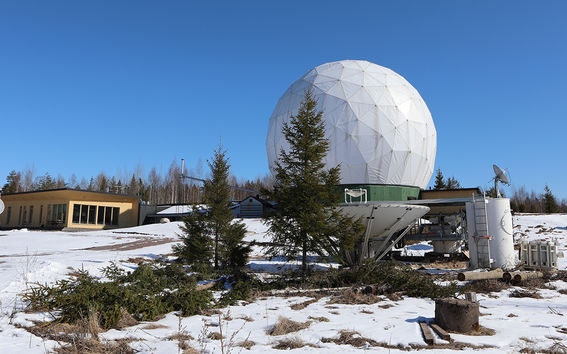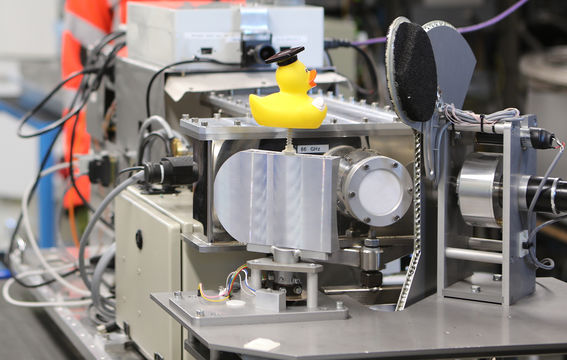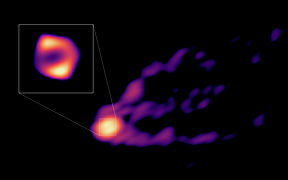Metsähovi Radio Observatory helps reveal the secrets of black holes

A yellow rubber ducky with a graduation cap watches over Senior Scientist Tuomas Savolainen and his colleagues as they prepare to change the receiver of the radio telescope at Metsähovi Radio Observatory in Kirkkonummi.
In 2019, there was a breakthrough in black hole research when an international team took the first picture of the giant black hole at the centre of the Messier 87 galaxy. Three years later, the black hole Sagittarius A* at the centre of our own Galaxy was imaged. As a member of the Event Horizon Telescope (EHT) collaboration, Savolainen was involved in making both images.
‘Those images were a huge success, but we knew that our work was only just beginning. The new image we’ve published today gives us a picture of the entire system surrounding the black hole at the centre of M87,’ he says.
The latest image was taken by a worldwide network of radio telescopes called the Global Millimeter VLBI Array (GMVA). The network used a technique called VLBI, or ‘very long baseline interferometry’, which combines information from several radio telescopes to make them act like a single telescope. In this case, the combined GMVA has the resolution of a telescope the size of the Earth. The new observations were also made using a longer wavelength than the EHT used – 3.5 mm instead of 1.3 mm.
‘In the new image, we see how the structures created by the inflow and outflow of gas surrounding the black hole are connected to each other and to the black hole itself,’ explains Savolainen. ‘The image shows a plasma jet that ejects from the vicinity of the black hole at almost the speed of light. For the first time, we can see the jet and the ring-like structure together in the same image, and we can also see where the jet comes from in relation to the black hole itself.’
‘We also see that the ring-like structure surrounding the black hole is somewhat larger and slightly thicker than seen with the Event Horizon Telescope,’ Savolainen continues. He explains that this is what they expected, since the longer wavelength used for these observations reveals more of the radiation from the gas accreting to the black hole.
Precision work for perfect photos
To create these images, each observatory uses an atomic clock to get precise and accurate timestamps for their data. The signals are then combined by a small supercomputer called a correlator. The data is synchronised via the timestamps, and mathematical methods are used to calculate the interference signal between each pair of telescopes. The results of these analyses provide information about what the source looks like. The GMVA data are combined at the correlator in the Max Planck Institute for Radio Astronomy in Bonn, Germany.
‘This indirect imaging process is quite challenging. VLBI technology involves many details that are rather confusing at first glance. For example, when creating an interference signal, the correlator has to recreate the situation that prevailed in the electromagnetic field in different parts of the globe at the time of measurements, but this can happen months after the actual observations have been recorded,’ says Savolainen.
To collect data for this collaboration, the receiver on Metsähovi's 14-metre parabolic radio telescope has to be very sensitive, which means it has to be cooled to just 15 or 20 degrees above absolute zero. This reduces the thermal radiation that would otherwise interfere with the observations.
‘Our high frequency receiver, which we changed in early April, is a VLBI-enabled receiver that is used to study the black hole in M87, among other things. We’ve used the receiver for nearly twenty years, and it’s been improved several times and also partly rebuilt,’ says Petri Kirves, a member of the Metsähovi Radio Observatory's technical service team.
So what’s the academic ducky for?

‘The story of the duck is a little funny,’ says Kirves. ‘It's a quiz prize from a remote seminar organised during the coronavirus pandemic. Around then, we were thinking about how to monitor the position of the receiver's moving mirrors. We got the idea of putting the duck on a stick and attaching it to the mirror. The duck is monitored by a webcam that constantly takes pictures of its position, so we can use it to ensure that the mirrors are positioned correctly.’
Savolainen is looking forward to more pictures that will reveal even more about the physics of black holes.
‘The measurements at Metsähovi continue, and hopefully we’ll learn new things about what is happening around the black hole. The new observations aim, among other things, to measure the magnetic field in the area where the jet is born, and we’ll also see if we can observe changes in the structure of the jet, which could limit physical models.’
Astronomers image a black hole’s shadow and powerful jet together for the first time
Aalto’s Metsähovi Radio Observatory took part in capturing the new image.

Read more news

Your voice gives away valuable personal information, so how do you keep that data safe?
With speech technologies becoming increasingly common, researchers want to make sure we don’t give away more information than we mean to.
Aalto in 2025: Quantum leaps, creative breakthroughs and solutions for a better life
Growth, technology and industrial renewal; human-centred solutions; health and everyday wellbeing; and enjoyable daily life and thriving communities.
Research Council of Finland establishes a Center of Excellence in Quantum Materials
The Centre, called QMAT, creates new materials to power the quantum technology of coming decades.






